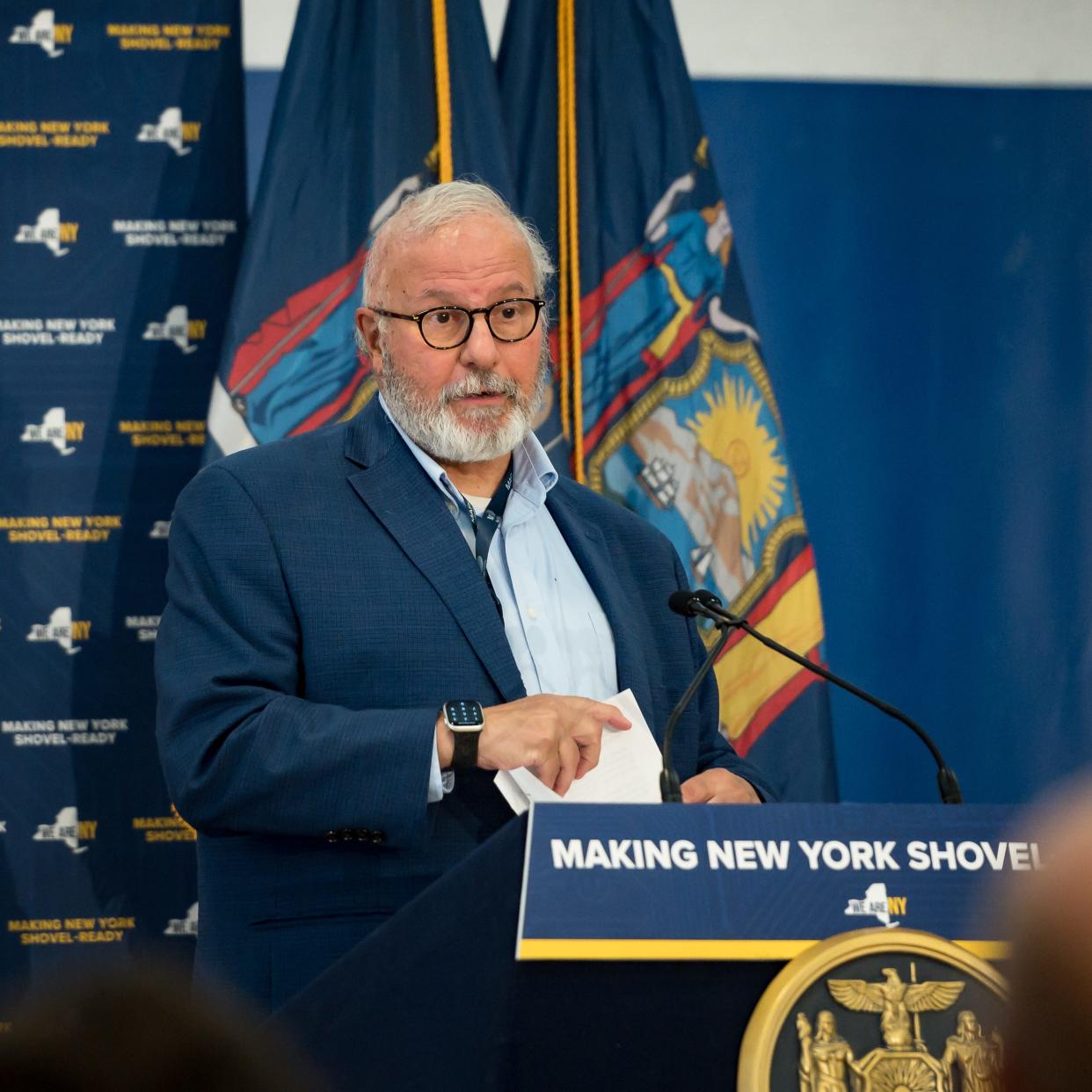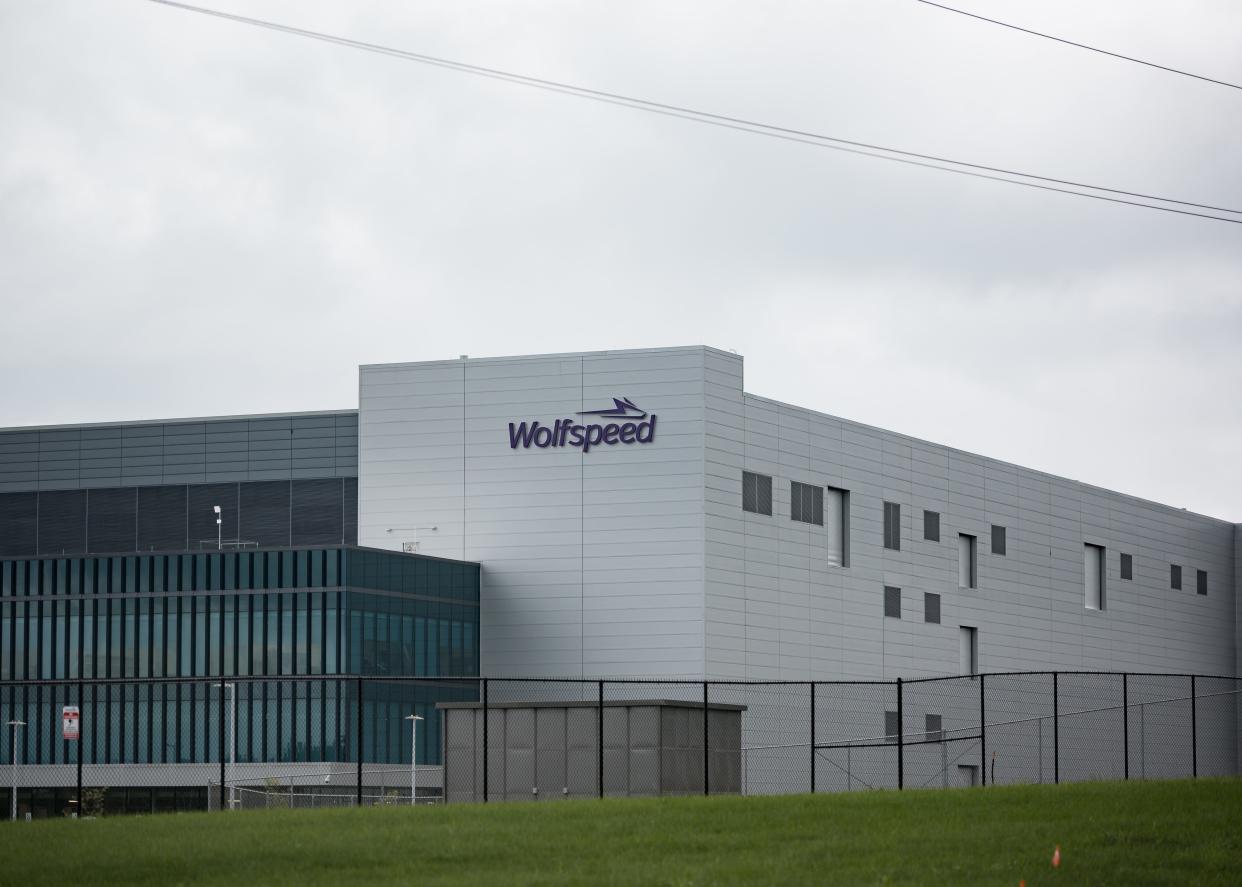Steve DiMeo legacy: Mohawk Valley EDGE president 'left this community a better place'
When Dianne DiMeo meets new people, they sometimes think they might know her husband.
They ask if she’s married to Mike DiMeo, a local band director and trumpet player, she said.
They seldom know Steve, her husband of 43 years.
As president of Mohawk Valley EDGE, Steve DiMeo, who died on March 6 at age 69, was one of Oneida County’s most influential people, but one who usually flew under the radar.
Thousands of people who likely never heard DiMeo’s name are working in jobs that DiMeo helped bring to this region, said Judge Anthony Brindisi, who worked with DiMeo frequently during his eight years as a state assemblyman and two years in Congress.

“It’s no secret the region went through a huge economic downturn in the 90s and early 2000s and a lot of people likely wrote off our area,” Brindisi said. “If it wasn’t for Steve, I don’t know if we would have made it out of some of those dark days during that time period. He, more than anyone, helped lead the economic turnaround for this community.”
DiMeo played a critical role in some of the area’s biggest economic development projects in recent decades and a smaller role in countless others. His vision was about more than creating jobs; it was about restoring local pride in his hometown and making sure young people wanted to stay in the Mohawk Valley, according to those who knew him best.
If you think things are getting better in the Mohawk Valley, if your children are thinking about raising their families here, if you’re proud of where you live, then you’re already living DiMeo’s vision of what the area can be, a vision forged one rehabbed building, one vacant parcel, one job, one thriving local business, one disc golf course at a time.
“The sad thing is people won’t know that,” Oneida County Executive Anthony Picente said. “People didn’t know that because Steve wasn’t in the forefront of that when the time came. He did the deal. He did the work and he didn’t seek the accolades.”
But people involved in economic development, whether politicians, state officials, business leaders, did know DiMeo’s name.
“Steve was a testament to how one person can make a difference,” said Kevin Younis, chief operating officer and executive deputy commissioner of Empire State Development. “Nobody has success by themselves, but there are individuals without whom there would not be that success. And Steve is absolutely one of those people for the Mohawk Valley.”
Major projects
DiMeo’s biggest and most obvious legacy is easy to see in three spots in Oneida County.
First there’s the Utica Business Park, a former golf course and DiMeo’s first major project when he worked as commissioner of urban and economic development for the city of Utica in the late 1980s.
And then working for the Oneida County Industrial Development Corporation and later its successor, MV EDGE, DiMeo was the mastermind behind the plan to redevelop the Griffiss Air Force Base in Rome into today’s Griffiss Business and Technology Park after the base closed in 1995.
He also fought to save the Air Force Research Laboratory in Rome from the Base Realignment and Closure Commission, or BRAC, process in both 1995 and 2005.
Creating the business park from the base was a jump into an uncharted territory of federal red tape, regulations and funding streams, but DiMeo got his bearings with remarkable speed, Picente said.
Today 90 businesses employing more than 7,000 people are located at Griffiss. And the formerly tax-exempt parcel produces more than $4.6 million in property taxes each year.
Rome Lab has an estimated economic impact of more than $500 million a year, according to EDGE.
And this year, Griffiss will likely reach the $1 billion mark for money invested there since the base closed, said Shawna Papale, a long-time EDGE employee who was named acting president after DiMeo’s death.
There are still military bases all over the country that have been abandoned with little or no redevelopment, Picente said.
“This one received numerous awards because of Steve’s redevelopment and planning,” he said. “He had the vision of what he thought it could be. He had the persistence to see that through and he had the smarts to know every aspect of what needed to be done to get there.”
'He just kept planting seeds'
And then there’s the Marcy Nanocenter, an idea first floated by the state back in the 1990s, an idea DiMeo spent decades studying and fighting to bring to fruition, staying firm to the task, despite the doubters who said it would never happen.
“That’s what it takes,” Younis said. “None of this happens overnight. He just kept planting seeds."
Under his direction, a meadow where deer once roamed blossomed into an infrastructure-rich, shovel-ready site in anticipation of everything a semiconductor firm could want.
It almost bore fruit in 2015 when AMS agreed to build a $2 billion wafer fabrication facility at the nanocenter. That deal fell through in December, 2016 and local officials blamed uncertainty and delays at the state level.
It was a blow, but those involved in the project said DiMeo never lost his faith; he just kept working toward a job-rich harvest.
And then the big announcement came in 2019, Cree Inc., now known as Wolfspeed, would build the world’s first/largest silicon carbide wafer fabrication facility at the nanocenter, a facility that opened in April, 2023.
“When people say that this project has had and will continue to have a transformative impact on our area’s economy, they’re not kidding,” Joseph Saunders, a long-time friend and Utica lawyer who worked with DeMeo, said in his eulogy during DiMeo’s funeral. “All you have to do is take a look around; the ripple effects of this project are visible everywhere.”
And the impact goes beyond Oneida County, including advanced manufacturing in Syracuse and Albany, Younis said. “Those companies, they are the future,” he said. “What’s happening at Griffiss today is the future of the Mohawk Valley ... I think that’s why Steve was so focused on semiconductors and those industries, because he knew what that meant for the future.”
Brindisi met DiMeo at a meeting shortly after he was elected to the New York State Assembly in 2011 and DiMeo talked about his work at Griffiss and plans for the nanocenter.
“I don’t think I’d heard the word nanotechnology until I met Steve DiMeo, to show my own ignorance,” Brindisi admitted. “But I can assure you that after I met Steve DiMeo, nanotechnology is a word I cannot get out of my head. The same probably goes for cybersecurity.”
More impact
When Dianne DiMeo called McGrath, Myslinski, Kowalczyk & Nunn Funeral Directors in Utica to make arrangements for her husband, she was surprised to hear a new story about her husband.
Back when the business wanted to build a new funeral home on vacant land, DiMeo had worked with them to get the permitting and financing in place, they told Dianne.
“I had no idea,” she said. “So it was kind of like this full circle kind of thing.”
There’s no telling just how many existing businesses and new projects DiMeo had a hand in, whether as a chief engineer or a behind-the-scenes figure giving advice.
He was involved in some way in Danfoss, Indium Fiber Instrument Sales, AIS, Black River Systems, Special Metals, the Wynn Hospital and the county parking garage under construction next to the hospital, just to name a few.
Business leaders throughout the county called him about “everything from soup to nuts,” Picente said. “There’s not a company that got established or expanded that he wasn’t a part of,” he added.
And, Picente said he shudders to think of the companies that may have left the area had DiMeo not stepped in to help, he said.
Danfoss Silicon Power came to Quad C on the SUNY Polytechnic Campus through a partnership with General Electric that ended up not working out. But DiMeo still had a big impact on Danfoss’ success, said Mike Hennessey, the former general manager of the Marcy site.
“He helped us as we were getting started here,” he said. “Empire State Development had some grants that we were getting, but Steve really helped us figure out how to get the business started up.
Coming to a community and figuring out how to get money for everything you need is one thing, Hennessey said. But getting things going and setting up operations is different, and DiMeo helped a lot with that, he said.
DiMeo even took on some challenges outside of his usual wheelhouse.
While he was working on Griffiss redevelopment, he got recruited —albeit reluctantly, Saunders said — to help plan a small event on the base: Woodstock ‘99.
He took his family on the last day of the four-day concert and drove them home, thinking the assignment was over, Saunders recalled in his eulogy. But DiMeo got a call just before he reached home.
“Okay, everyone out,” he said, according to Saunders' story. “I’ve got to get back to Griffiss. The place is burning down.”
His vision
Decades ago, when most area residents had never heard of nanotechnology or semiconductors, DiMeo started to form his vision of the region’s future, one that encompassed much more than jobs and advanced technology.
HIgh-tech firms were the anchor, bringing jobs with good salaries to area residents who would be trained for those jobs in local BOCES career-and-technical education programs and in local colleges. More companies would come to support and work with those firms.
And the spinoffs from more people coming to the region and from all those healthy paychecks would be more restaurants, more stores, more housing, more amenities to make people want to live in the Mohawk Valley.
With DeMeo, the idea was never to finish a new building and move on to the next thing, Picente said.
At Griffiss, for example, his plans included a sculpture garden and nature trail with a disc golf course. The sculptures raised eyebrows at first, Picente acknowledged.
But DiMeo always looked at the overall experience when doing projects, Picente said. “He didn’t rest on ‘OK, that’s one done and we’ll just move on now,’” he said. “There’s more to do now and there’s more to keep it going.”
That’s because his goal was to create a thriving community, Papale said.
“To help this community rise above where it’s been, the struggles over the years of losing some of the (manufacturing) base and (General Electric) pulling out,” she said. “His view was we need to take that and move the community beyond that needle.”
And his vision was not to leave anyone behind. DiMeo was concerned about training and bringing into the workforce refugees and other hard-to-reach groups, Papale said. He tried to find ways around barriers like the cost of education, transportation, day care and housing, she said.
All of that vision really boiled down to family, Dianne DiMeo said. His deepest concern was in “keeping young people here and making sure they have opportunities for good, productive lives,” she said.

That vision paid off in his own family. DiMeo’s oldest son, Bob, and his wife live in Marcy and work at the Rome Laboratory, a major local, high-tech employer his father fought to keep. And his daughter Allison works as a physician assistant for the Mohawk Valley Health System.
(His younger son Jonathan lives in Florida married to a Florida native, former O-D photographer Tina Russell.)
And DiMeo was a great salesman for his vision, Papale said.
“He made you come along,” she said. “He was a believer. He didn’t pound his chest. He brought you along to the story he was telling. And that story was changing a community that didn’t believe in itself for years.”
How he did it
DiMeo loved his job. He also loved movies, history, World War II movies in particular, and the Yankees. What he liked about the war movies, was looking at the strategy behind the decisions made by the generals, his wife said. And the same was true for baseball, she said.
Winning on a battlefield, winning a ballgame and getting an economic development project to come to fruition all have one thing in common, Dianne DiMeo said. “It’s strategic,” she said. “It’s not just happenstance.”
Long-term strategy was a big part of DiMeo’s success. But people who knew him well described a number of key characteristics and habits that made him good at his job: tenacity, creative problem solving, an amazing memory, attention to detail and the ability to see the big picture, a willingness to study long and hard, an understanding of businesses’ needs, a brain that never stopped cranking, a dedication to hard work, shower-driven brainstorming, middle-of-the-night emails to colleagues and, as Hennessey put it, his ability to act as a “human spreadsheet, sometimes spitting out these numbers and running these calculations.”
“Steve had the rare ability to envision what a deal structure should look like,” Saunders said in his eulogy. ‘And he could figure out a way to finance the deal when others couldn’t. He was a planner, a risk taker and, most importantly, a builder. Steve always got the job done.”

He also dove into research, reading, talking to experts, watching videos until he understood the semiconductor industry well enough to speak to members in their own language and to understand their needs.
“He knew what he was talking about,” Dianne DiMeo said. “He knew the industry he was talking about. He knew his community. He knew what the assets were.”
Longevity was another key, Papale said.
“Our project is never done,” she said, expressing DiMeo’s philosophy. “Once the ribbon is cut and it’s announced, we’re in the long haul with these companies.”
Human legacy
One of DiMeo’s five grandkids recently drove past Wolfspeed with his mother, Dianne DiMeo said. Oliver, 3, pointed at the building and said, “My papa built that.”
Some of DiMeo’s legacy is easy for anyone to spot. Much of it is more subtle.
Another of DiMeo’s granddaughters just turned six. She sleeps every night with a stuffed Simba DiMeo bought for her at Disney when she was a year old, Dianne DiMeo said.
That, too, is legacy.
“Just the fact that he has these five little grandkids all of whom are fairly close in age was a legacy that he was very proud of,” his wife said.
And DiMeo leave behind another human legacy, Papale said — the staff at MV EDGE. After DiMeo’s sudden death, Papale told the staff during a meeting to look left and right.
“He’s in all of you,” she said.
He also left behind tomes of details about projects, lists of projects for the future and endless emails with his thoughts, Papale said.
“He shaped an organization here of staff people who learned from him,” she added. “When I hear people talking here on the staff, I can hear him talking out of their mouths … To me, that was a good trait of a good leader, empowering the people around you to run with the vision.”
And that means that DiMeo’s vision will continue and his legacy will continue to grow because MV EDGE is ready and able to carry on the work that DiMeo began, Papale said.
Oneida County legacy
What would DiMeo hope his legacy would be?
Dianne DiMeo gave careful thought before answering, “Just the fact that he was able to go beyond the doomsday — the base is closing or the businesses are leaving,” she said. “I think that his legacy is of taking a situation and making it into something good. That has a lasting effect.”
Papale also pointed to a less tangible impact of his legacy. People are talking about their children moving back to the area and about all the job opportunities, she said.
“That’s part of the fallout. It’s a better economy,” she said. “It’s a better psyche in the community. It’s not the stuff you can see.
“You have people looking at this region who otherwise might not have years ago.”
Looking at Wolfspeed, Danfoss and all the high-tech companies in the area carries Hennessey back in time, he said.
“This reminds me of upstate when I was growing up as a kid,” Hennessey said. “There are big companies up here doing very well. I think in 10 years, you’re going to see the same thing. He’s definitely got a piece of that legacy.”
Papale summarized what may be DiMeo’s most important legacy succinctly: “He’s left this community a better place than when we started.”
Brindisi put it even more simply, “He was darn good at his job.”
This article originally appeared on Observer-Dispatch: Steve DiMeo of Mohawk Valley EDGE leaves economic development legacy
